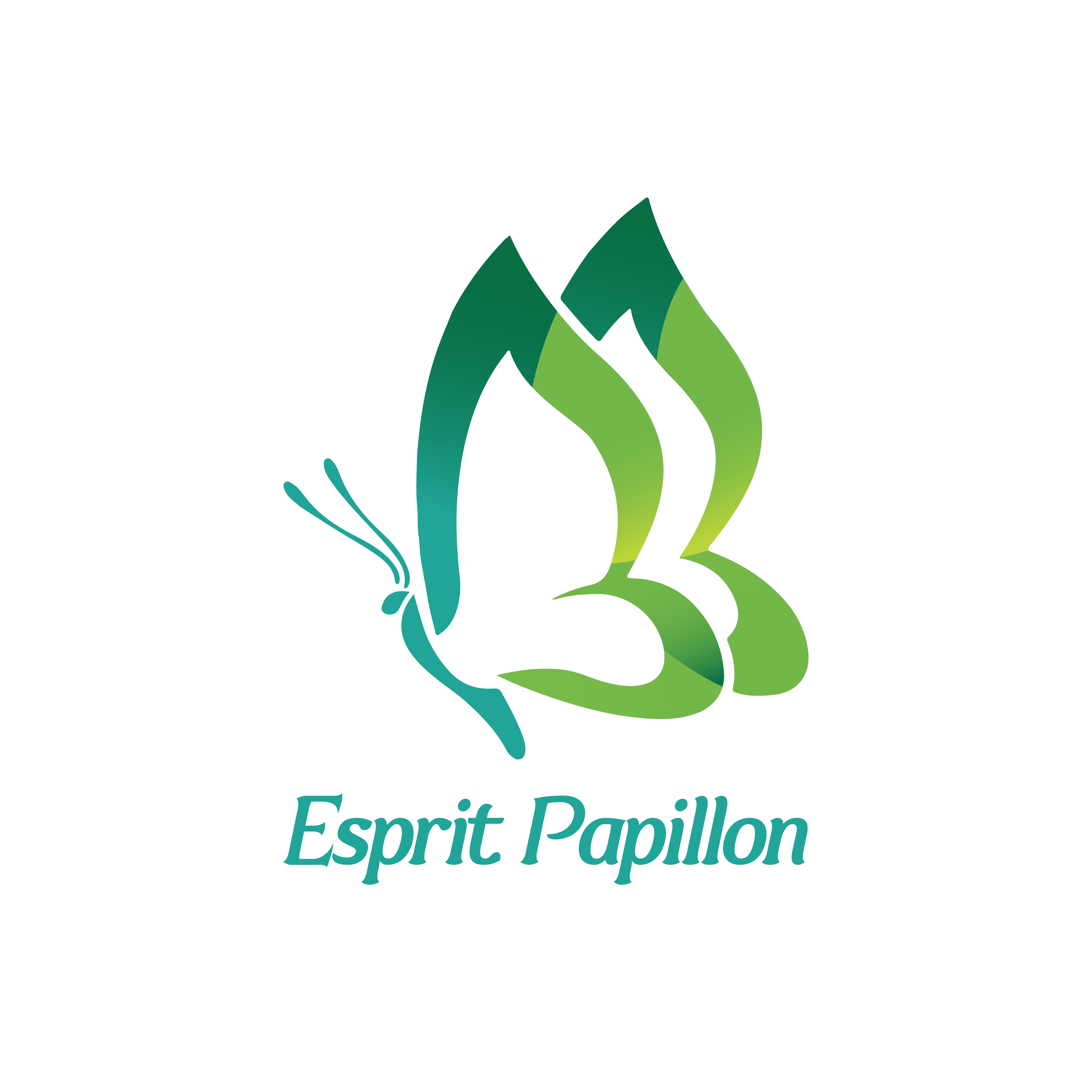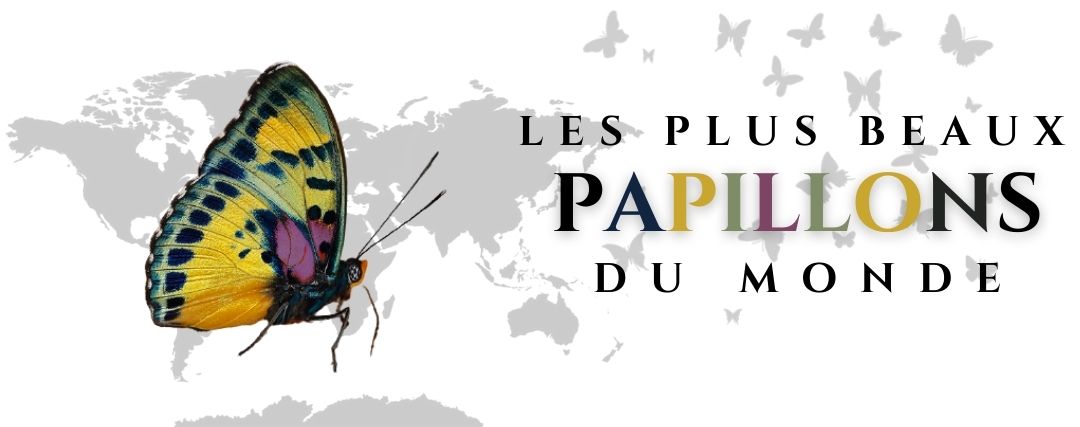Butterflies are fascinating insects that are easy to observe in the field. They belong to the family Lepidoptera, a Greek-origin word meaning "wings with scales", which includes both butterflies and moths.
These wings, full of pigmented and reflective scales, give butterflies their spectacular and striking colors. Besides being delightful to observe, these colors play a crucial role in the reproduction and survival of butterflies.
Their incredible beauty is a great source of inspiration in jewelry. You can see for yourself by visiting our collection of butterfly rings.
In this article, we present to you some of the most beautiful butterflies in the world. Discover now these wonderful insects, witnesses of the beauty of nature.
1) The Moduza Procris

The Moduza Procris, from the Nymphalidae family, is a butterfly with sublime colors and a wingspan of approximately 6 to 7.5 cm. The upper part of its wings is colored a shiny reddish brown. Towards the center of the wing, there are large white spots.
This species is found in South Asia and Southeast Asia, in heavily forested areas that receive high levels of precipitation, at altitudes between sea level and around 400 meters.
The Moduza Procris, also called " The Commander", is generally found in forested regions where rainfall is moderate to heavy. It is usually found at low altitudes, up to 900 meters (3,000 feet) in the hills.
It favors open clearings, roadsides, and forest clearings. It is abundant along streams in dry and moist deciduous forests. It is also found near villages, wherever its larval host plant Mussaenda frondosa is found. It is more common in the post-monsoon months and in winter.
Similar species: Doxocopa linda, Anartia amathea
2) The Heliconius Cydno
Heliconius cydno, named cydno longwing in English, is a butterfly of the Nymphalidae family, with a wingspan of 7 to 8 cm. Its wings are enhanced by their midnight blue color, perfectly contrasted by a white stripe separating the center and the end of the wings.
It extends from Mexico to northern South America. It is typically found in the understory of forests and lays its eggs on a variety of Passionflower plants.
This butterfly is also characterized by hybridization and Müllerian mimicry. Wing coloration plays a key role in mate choice and has further implications regarding sympatric speciation. Macrolide scent gland extracts and wing-clapping behavior further characterize this species.
Similar species: Heliconius sapho, Heliconius sara, Heliconius hewitsoni, Heliconius xanthocles
3) The Dione Moneta

Dione moneta, also called Mexican Silverspot or Moneta Longwing in English, is a species of lepidopteran belonging to the family Nymphalidae. Its wingspan is 7 to 8.3 cm.
This species, which is divided into three subspecies, is distributed from the southern United States to South America, with a high concentration in Central America. It is mainly found in heavily sunny areas of tropical forests, between 500 and 3500 meters above sea level.
This butterfly is characterized by the brown and orange color of its wings, accompanied by thick black veins. The nuance of its colors is very pleasant to observe.
Similar species: Argynne cybele, Brenthis ino, Hamearis lucina
4) The Monarch

The monarch butterfly, of the family Nymphalidae, is one of the most easily recognizable butterfly species in North America. It has a wingspan of 7 to 10 centimeters.
Present all over the world, this lepidopteran is above all famous for its migration from Canada to Mexico. Every fall, monarchs undertake a journey of approximately 4,000 to 5,000 km to the Mexican mountain forests.
Its wings are a deep orange with black borders and veins, and white spots along the edges. A magnificent butterfly!
Similar species: Dryadula phaetusa, Limenitis archippus, Danaus chrysippus
5) The Pachliopta Hector

Pachliopta hector also called Crimson Rose in English. It is a splendid butterfly of the Papilionidae family, with a wingspan of approximately 10 to 11 cm.
It is found in India where it is protected by law, Sri Lanka, the Maldives, and possibly the west coast of Myanmar.
Its forewings are black with white bands, and its hindwings are black with white outlines and red spots. The body of Pachliopta hector is crimson red over its entire length with black localized on the wings and legs.
Similar species: Papilio polytes romulus, Papilio bootes, Parides ascanius
6) The Apollo (Parnassius Apollo)

An emblematic species of the mountains of Eurasia, the Apollo is a superb butterfly with a wingspan of 6 to 9 cm. This typically montane species prefers the hills, flowering alpine meadows, and mountain pastures of continental Europe, in Spain, Scandinavia and central Europe, in the Balkans to northern Greece and in the Alps between Italy and France.
In France, although it has disappeared from many regions, it is possible to observe it in the Pyrenees, the Massif Central or even the Alps at an altitude of 400 to 2300 meters.
These beautiful white butterflies are decorated with black eyespots on the forewing and red or sometimes orange eyespots on the hindwing. Their wings are shiny, with slightly transparent edges.
Similar species: Parnassius phoebus, Anteros formosus
7) The Haetera Piera

The Haetera Piera, also called "the amber ghost", is a butterfly of the Nymphalidae family.
It is a species native to South America, found in countries such as: Brazil, Peru, Ecuador, Suriname, Colombia, and Guyana.
This butterfly has one particularity: its transparent wings. They are pearly, with brown veins and eyespots, as well as some orange/red coloring present on its hindwings. The particular structure of its wings allows it to let light pass through, which gives it excellent camouflage to avoid its predators.
Similar species: Greta oto, Episcada hymenaea
8) Chrysiridia Rhipheus

The Chrysiridia rhipheus, also called "Sunset moth" in English, is a species of butterfly in the family Uraniidae. It has a wingspan of 7 to 9 cm.
It is a famous butterfly throughout the world and is highly sought after by collectors. It is found throughout the year in most areas of the island of Madagascar, with population peaks between March and August.
Its multicolored wings are the result produced by the conjunction of two optical phenomena linked to the scales. The color observed in each part of the wing is the combination of colors reflected by these two phenomena. A butterfly with incredible colors to see with your own eyes!
Similar species: Urania leilus
9) Jemadia pseudognetus

The Jemadia pseudognetus, named Dot-collared Skipper in English, is a species of lepidoptera belonging to the Hesperiidae family.
This pretty butterfly is found in primary rainforests from southern Mexico to Peru and southwest Brazil. It is present at altitudes between 200 and 800 meters.
It is characterized by its striped thorax and its blue-barred abdomen, which matches wonderfully with its black wings with blue reflections, on which stripes are nicely drawn which offer us beautiful shades of blue.
Similar species: mimoniads versicolor, Jemadia gnetus, phocides metrodorus
10) The Emerald Swallowtail (Papilio Palinurus)

The Emerald Swallowtail, or Papilio palinurus, belongs to the Papilionidae family. It is a lepidopteran with a wingspan of between 8 and 10 cm.
This butterfly lives in primary Asian forests and is mainly found in Southeast Asia (Philippines, Borneo, Sumatra, Indonesia, Burma, Peninsular Malaysia)
The dorsal surfaces of the wings are covered in a powder of green scales, and the background varies from dark greenish to black, with broad, bright emerald green metallic bands. Another grandiose spectacle that nature offers us.
Similar species: Papilio buddha
11) Proserpine (Zerynthia rumina)

The Proserpine is a butterfly of the Papilionidae family with a wingspan of 22 to 25 cm on average.
This beautiful species is found in southern France, as well as the Liguria region of Italy and the Iberian Peninsula. It is particularly present in the Mediterranean scrublands, at an altitude of up to 1300 m.
Its wings have a light yellow background color and are dotted with black spots and scalloped lines of the same color, which make the Proserpina very pleasant to observe. Added to this are small red spots, serving as a warning to possible predators!
Similar species: Zerynthia polyxena, Euphydryas aurinia
12) The Junonia Orithya

Junonia orithya or Blue Pansy (Precis orithya) is a species of Lepidoptera belonging to the Nymphalidae family. It has a wingspan of 4 to 6 cm.
This butterfly is found in sub-Saharan Africa, Arabia, and most of the eastern and Australian regions. In Australia, it occurs in the Northern Territory, North West Australia, Torres Strait Islands, Queensland, and New South Wales.
This species, like most other species in the genus, is found primarily in open habitats, including grasslands, savannah and woodland mosaics, large clearings in forests, and agricultural lands. It is primarily a lowland species, found at altitudes from sea level to around 300 meters.
This absolutely sublime butterfly has wings whose blue and black colors match perfectly with the orange of its eyespots.
Similar species: Inachis io, Junonia genoveva
13) The Swallowtail

The Swallowtail butterfly is a lepidoptera of the Papilionidae family. It has a wingspan ranging from 6.5 to 8.6 cm. It is one of the most beautiful species observable in France.
The Swallowtail is found throughout Eurasia. It has a very good capacity for adaptation and thus uses a wide variety of habitats. The subarctic tundra in Canada; arid prairies, woodlands, and canyons in the southern United States; hay meadows, roadsides, river banks, and subalpine pastures in Europe; high mountain habitats in the Atlas Mountains in North Africa or even semi-cultivated habitats in the Mediterranean region.
In France, it is found mainly in summer in wild meadows. You can also see it in town gathering nectar from a Buddleia (butterfly tree).
The Papilio machaon has a black coloring with a yellow base color. Blue and red spots are present on the hindwings. A mutation or variation in the natural color of swallowtails is the occasional appearance of melanism, a black coloration on the wings, rather than yellow.
Similar species: Papilio hospiton, Papilio alexanor
14) The Troides Minos (Southern Birdwing)

Second largest butterfly in India, the Troides Minos is a butterfly with a wingspan of 14 to 19 cm, which belongs to the Papilionidae family.
Endemic to South India. It is found in the states of Kerala, Karnataka, Goa, Maharashtra, Tamil Nadu, and Andhra Pradesh. It is present in all types of habitats where its host plant (Aristolochia) is present, including coastal regions, agricultural lands, urban areas, residential areas, and all types of forested areas.
The Troides Minos has black forewings enhanced by veins outlined in white, and yellow hindwings with black veins. Easily identifiable, this lepidopteran is simply magnificent!
Similar species: Troides helena, Troides doherty
15) The Chorinea Sylphina

The Chorinea sylphina is a butterfly belonging to the Riodinidae family.
This moth is found in Ecuador, Peru, and Bolivia. It lives in tropical forests found at altitudes between 2000 and 3000 meters.
In flight, the transparent wings of this exquisite butterfly reflect a myriad of iridescent green, blue, and pink hues that offer the observer a true spectacle for the eyes. We also appreciate the superb blue coloring of its hindwings.
Similar species: Chorinea amazon, Rhetusa arcius, Rhetusa dysonii
16) The Janetta Forester

The Janetta Forester is a butterfly of the Nymphalidae family.
It is found in Guinea, Sierra Leone, Benin, Liberia, Ghana, Togo, Ivory Coast, Nigeria, Cameroon, Equatorial Guinea, Central African Republic, and the Democratic Republic of Congo.
This moth is a tropical rainforest inhabitant and is found at altitudes between sea level and around 1000 meters. It survives well in lightly degraded forests and also breeds in riparian forests and some woodland/savannah habitats.
The deep blue of its wings contrasts with a metallic blue tending to yellow. Two yellow spots on each side embellish the aesthetics of the wings of this sublime butterfly.
Similar species: Napeocles jucunda
17) The Bhutan Glory ( Bhutanitis lidderdalii)

The Bhutan Glory is a butterfly of the Papilionidae family with a wingspan ranging from 9 to 11 cm. It takes its name from the country where it was discovered in 1868, which is Bhutan.
This lepidopteran is present in Bhutan and northeast India. It is also found in northern Myanmar, Thailand, Vietnam, Laos, and the Chinese provinces of Szechwan and Yunnan. It flies at an altitude between 1500 and 2700 meters and generally hangs on ridges rather than valleys.
Visually stunning, the Bhutan Glory exhibits no notable sexual dimorphism. The upper surface of its wings is generally a dull black color. This pattern allows it to camouflage itself in the shade of trees. Additionally, very fine, cream-colored streaks run vertically across the wings, creating a striking appearance. A wonderful contrast of small colored spots appears at the base of the hindwings, further increasing the charm of this butterfly.
Similar species: Bhutanitis thaidina
18) Troides brookiana (Rajah Brooke's birdwing)

The Troides brookiana or Trogonoptera brookiana, is a butterfly belonging to the Papilionidae family. This large lepidopteran has a wingspan of between 12 and 18 cm.
It is present in the Natuna Islands, Borneo , the Malay Peninsula ( Malaysia and Thailand ) and many small islands in West Sumatra (Mentawai Islands, Batu Islands, Banyak Islands and Simeulue ) . It lives in tropical forests.
When the wings are open, the dorsal surfaces of the two elongated primary wings of males display a series of green leaf-like patterns on a black base, gradually decreasing in size toward the tip. The small secondary wings are also black with spots of the same green pigmentation. An elegant butterfly!
Similar species: Ornithoptera priamus poseidon, Philaethria dido, Siproeta stelenes
19) The Polygonia Interrogationis

The Polygonia Interrogationis is a butterfly that belongs to the Nymphalidae family. It has an average wingspan of 5.2 to 6.4 cm.
It is found in the eastern United States and southeastern Canada. This moth lives in areas with open spaces and trees such as parks and wooded areas.
The wings of this lepidoptera have a most majestic shape! They are brownish-orange with some black spots and a pale lilac lower outline. These magnificent shades of color give it a harmonious aesthetic.
Similar species: Nymphalis polychloros, Nymphalis xanthomelas, Polygonia c-album
20) The Blue Morpho

The blue Morpho butterfly, whose Latin name is "Morpho menelaus", is a lepidoptera famous for the bright blue reflection of its wings. It belongs to the Nymphalidae family. It is one of the largest butterflies with a wingspan ranging from 12 to 21 cm.
It is found in Central and South America and lives mainly in shrubs and other low-lying areas. These butterflies do not care for nectar from flowers; they prefer rotten fruits or tree sap.
The wings of this species are a great example of iridescent blue coloration in the insect world. It is one of the most famous butterflies in the world, and its beauty has everything to do with it!
Similar species: Morpho helenor, Morpho Rhetenor
Beautiful butterfly species to suggest?
Many butterflies deserve their place in this article. However, it is unfortunately not possible to integrate them all, because that would be endless. We, therefore, invite you to share in comments the species that you think deserve to be found in this blog article dedicated to the most beautiful butterflies in the world!






tache
magnifique
Exel
Le papillon Argus bleu est également très beau aussi
Exel
Le papillon Argus bleu est également très beau aussi
Malengret Philippe
Et l’Uranie de Madagascar ?
Arnoux Michel